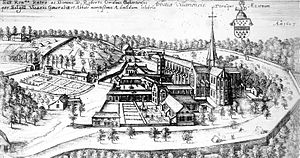|
Villers Abbey
Villers Abbey (French: Abbaye de Villers) is a former Cistercian abbey located in the town of Villers-la-Ville, Walloon Brabant, Belgium. Founded in 1146, the abbey was abandoned in 1796. Most of the site has since fallen into ruins. These ruins now belong to the Walloon Region and are classified as part of Wallonia's Major Heritage. HistoryIn 1146, twelve Cistercian monks and three lay brothers from Clairvaux came to Villers in order to establish the abbey on land granted to them by Gauthier de Marbais. After establishing several preliminary sites (Villers I and Villers II), work was finally undertaken in the 13th century to build the current site. The choir was constructed by 1217, the crypt by 1240, and the refectory by 1267. The church itself took 70 years to build and was completed by the end of the century.  During this period, the abbey reached the height of its fame and importance. Contemporary accounts suggest that roughly 100 monks and 300 lay brothers resided within its walls,[1] although this is possibly an exaggeration. The lands attached to the abbey also expanded considerably, reaching some 100 km2 (39 sq mi) of woods, fields, and pasturage. Decline set in during the 16th century, tied to the larger troubles of the Low Countries. Spanish tercios, during the campaign of 1544, did considerable damage to the church and cloister, both of which were partially restored in 1587. In the early 17th century, Crisóstomo Henríquez wrote the history of the abbey. In the 17th and 18th centuries, the abbey's fortunes continued to diminish. The number of monks and the abbey's wealth dwindled, and it was finally abandoned in 1796 in the wake of the French Revolution. After dissolution  Further degradation to the site occurred in 1855, when the railway line between Ottignies-Louvain-la-Neuve and Charleroi passed through the old abbatial grounds.[2] In 1893, the Belgian state purchased the site and launched a conservation effort. Classed as an official historic site in 1973, the abbey has subsequently enjoyed considerable restoration, and the remains of the abbey along with numerous outbuildings can still be seen, including the cloister, refectory, kitchens, dormitories, and brewing house. Since 1992, the site has been maintained by the Association pour la Promotion Touristique et Culturelle de Villers (APTCV). The church, although in ruins, is an outstanding example of Cistercian architecture, with imposing vaulting, arches, and rose windows. The abbey now hosts an annual choir festival La Nuit des Chœurs in which a number of choirs sing a variety of music—classical through to gospel, jazz and pop arrangements—from different parts of the grounds over successive nights, culminating in a fireworks display and centre stage concert. Burials
Bibliography
References
External links
|
||||||||||||||||||||||||||
Portal di Ensiklopedia Dunia

